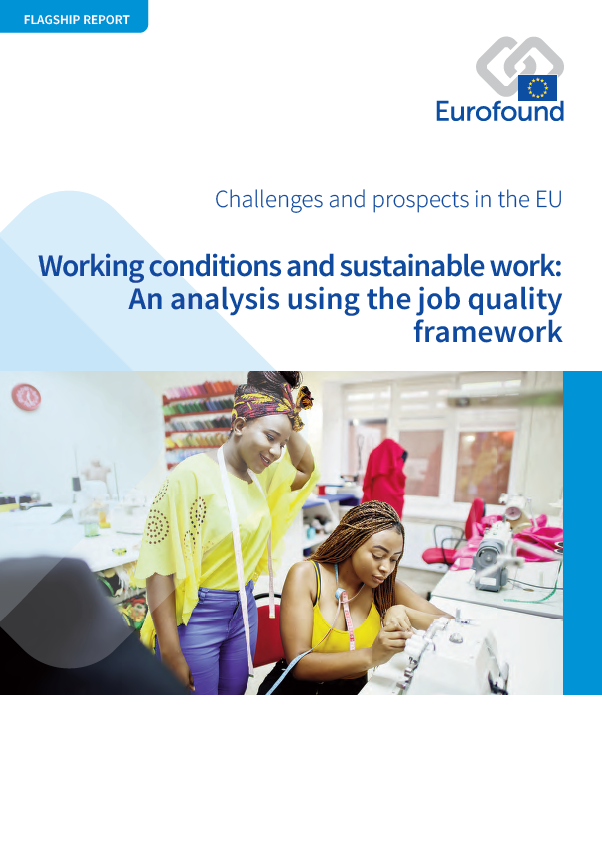
Acest raport emblematic sintetizează principalele constatări ale cercetărilor Eurofound privind condițiile de muncă, desfășurate pe parcursul perioadei de programare 2017-2020. Se cartografiază progresele înregistrate începând cu anul 2000 în ceea ce privește îmbunătățirea condițiilor de muncă și se analizează dacă toți lucrătorii au beneficiat în mod egal de schimbări pozitive. Raportul evidențiază categoriile care riscă cel mai mult să se confrunte cu condiții de muncă precare și să fie lăsate în urmă. Având în vedere modificările din lumea muncii, sunt identificate noi provocări în ceea ce privește o calitate adecvată a locurilor de muncă. De asemenea, raportul prezintă dovezi privind măsurile care ar putea duce la îmbunătățirea în continuare a activității și la asigurarea unor condiții de muncă echitabile pentru toți cetățenii din UE.
Analiza arată că, per ansamblu, calitatea locurilor de muncă din UE se îmbunătățește, deși într-un ritm lent. Nu toți lucrătorii beneficiază însă de acest aspect în aceeași măsură. În plus, sexul, vârsta și statutul contractual influențează semnificativ condițiile de muncă ale unei persoane. Deși digitalizarea contribuie la abordarea unor aspecte legate de calitatea locurilor de muncă, aceasta creează totodată noi provocări. Pandemia de COVID-19 a exacerbat tendințele, accentuând preocupările și arătând cât este de important să se asigure calitatea locurilor de muncă pentru toți.
Key findings
În medie, lucrătorii din UE se bucură de condiții de muncă mai bune în prezent decât la începutul mileniului. Calitatea timpului de muncă s-a îmbunătățit în mod clar, dar și mediul fizic este mai favorabil, mai ales acolo unde acest aspect este cel mai important: în cazul ocupațiilor cu expunere mare la riscuri fizice.
Locurile de muncă din prezent necesită competențe sporite și oferă o autonomie mai mare decât cele din trecut. Acest lucru se reflectă într-o îmbunătățire a indicelui referitor la competențe și la discreție.
Dezvoltarea competențelor lucrătorilor este îngreunată de inegalitățile în ceea ce privește accesul și participarea la formarea profesională plătită de angajator. Angajații mai în vârstă participă mai puțin la activități de formare profesională, iar decalajul în ceea ce privește accesul la această formare dintre angajații cu statut contractual diferit (cu contracte de muncă cu normă întreagă / cu normă redusă, cu contracte de muncă pe perioadă nedeterminată / pe perioadă determinată) se accentuează.
Faptul că pe piața muncii persistă segregarea de gen se reflectă în diferențele dintre bărbați și femei în ceea ce privește calitatea locurilor de muncă. Însă nu există un câștigător absolut. Diferențele dintre sexe pot fi și în detrimentul bărbaților, de exemplu în ceea ce privește mediul fizic.
Deși perspectivele profesionale s-au îmbunătățit în general atât pentru bărbați, cât și pentru femei, bărbații și-au menținut avantajul în această dimensiune a calității locurilor de muncă. Cauza cea mai probabilă este distribuția inegală a responsabilităților de îngrijire, concretizată în pauze profesionale mai lungi și în planificarea diferită a timpului de lucru pentru femei.
Based on the European Working Conditions Survey (EWCS) 2015 analysis, the data below accompany Eurofound's flagship report on working conditions and sustainable work and focus on job quality for different occupational profiles.
- Data: Job quality in the EU
The flagship report also has the following list of tables and figures.
List of tables
Table 1: Change in the composition of the workforce, EU27 and the UK, 2002–2019
Table 2: Elements of the job demands–resources model based on the EWCS
List of figures
Figure 1: The seven dimensions of job quality and the indicators composing each dimension
Figure 2: Indexed change in job quality indices, EU27 and the UK, 2000–2015
Figure 3: Physical environment index: mean and standard deviation, by occupational category, EU27 and the UK, 2000–2015
Figure 4: Work intensity index: mean and standard deviation, by sector, EU27 and the UK, 2000–2015
Figure 5: Work intensity index: mean and standard deviation, by country cluster, EU27 and the UK, 2000–2015
Figure 6: Skills and discretion index: mean and standard deviation, by occupational category, EU27 and the UK, 2000–2015
Figure 7: Skills and discretion index: mean and standard deviation, by country cluster, EU27 and the UK, 2000–2015
Figure 8: Participation in paid training (%), by employment and contractual status, EU27 and the UK, 2005–2015
Figure 9: Associations between working time quality and occupational category, by country cluster
Figure 10: Working time quality index: mean and standard deviation, by country cluster, EU27 and the UK, 2000–2015
Figure 11: Long working hours (%), by employment status, EU27 and the UK, 2000–2015
Figure 12: Prospects index: mean and standard deviation, by occupational category, EU27 and the UK, 2005–2015
Figure 13: Prospects index: mean and standard deviation, by country cluster, EU27 and the UK, 2005–2015
Figure 14: Scores on Prospects index, by employment and sociodemographic characteristics, EU27 and the UK, 2005 and 2015
Figure 15: Receipt of support from colleagues and managers (%), EU27 and the UK, 2005–2015
Figure 16: Receipt of support from colleagues and managers (%), by age group, EU27 and the UK, 2005 and 2015
Figure 17: Exposure to adverse social behaviour (%), by gender, EU27 and the UK, 2010 and 2015
Figure 18: Perception of fair pay (%), by Member State and the UK, 2005–2015
Figure 19: Perceived appropriateness of pay, by country cluster, EU27 and the UK, 2005–2015
Figure 20: Job quality profiles: Scores on seven job quality indices, EU27 and the UK, 2015
Figure 21: Distribution of workers according to job quality profiles, EU27 and the UK, 2015
Figure 22: Job quality profiles of men, by job quality indices, EU27 and the UK, 2015
Figure 23: Job quality profiles of women, by job quality indices, EU27 and the UK, 2015
Figure 24: Distribution of employees according to predominant gender in occupation (%), by gender, EU27 and the UK, 2010 and 2015
Figure 25: Gender of immediate manager (%), by worker’s gender, EU27 and the UK, 2005–2015
Figure 26: Female employees reporting good prospects for career advancement and gender gap (%), EU27 and the UK, 2005–2015
Figure 27: Good prospects for career advancement (%), by age and gender, EU27 and the UK, 2005–2015
Figure 28: Job insecurity according to predominant gender in occupation (%), by gender, EU27 and the UK, 2010 and 2015
Figure 29: Employability according to predominant gender in occupation (%), by gender, EU27 and the UK, 2010 and 2015
Figure 30: Employees reporting difficulty making ends meet according to occupation type (%), by gender, EU27 and the UK, 2015
Figure 31: Employees reporting difficulty making ends meet according to household type (%), by gender, EU27 and the UK, 2015
Figure 32: Employee experience of selected emotional demands (%), by gender, EU27 and the UK, 2010 and 2015
Figure 33: Average weekly working hours of employees across the life course, by gender, EU27 and the UK, 2015
Figure 34: Flexibility to take time off according to predominant gender in occupation (%), by gender, EU27 and the UK, 2010 and 2015
Figure 35: Additional components of earnings from main job (%), by gender, EU27 and the UK, 2005–2015
Figure 36: Employees’ perception of their work–life balance (%), by age, EU27 and the UK, 2015
Figure 37: Employees’ participation in training (%), by age and training classification, EU27 and the UK, 2015
Figure 38: Associations between demands and resources and workers’ health and well-being
Figure 39: Proportion of workers with flexitime schedules and engaged in TICTM (%), EU27 and the UK, 2015
Figure 40: Workers reporting work–life balance problems (%), by work arrangement and presence or absence of children, EU27 and the UK, 2015
Figure 41: Multiple-job holders as a proportion of total employment (%), by gender and country, EU27 and the UK, 2018
Figure 42: Job quality profiles of multiple-job holders’ main jobs, by gender, EU27 and the UK, 2015
Figure 43: Job quality of selected critical occupations in relation to the workforce average
Figure 44: Emotional demands on ISWs and extent of those demands (%), EU27 and the UK, 2015
- Number of pages
-
80
- Reference nº
-
EF20021
- ISBN
-
978-92-897-2150-9
- Catalogue nº
-
TJ-03-21-030-EN-N
- DOI
-
10.2806/938302
- Permalink
Members of Eurofound’s Management Board provide their reactions to and insights into Eurofound’s 2021 flagship report on Working conditions and sustainable work: An analysis using the job quality framework.
- Impact of the Covid-19 pandemic
Interview with Juha Antila, Head of Research and Development SAK, Central Organisation of Finnish Trade Unions.
- Digitalisation
Interview with Mario van Mierlo, Deputy Director, Social Affairs, The Dutch Confederation of Industry and Employers (VNO-NCW).
- Making work sustainable
Interview with Alain Piette, Ergonomist at the Belgian Federal Public Service Employment, Labour and Social Dialogue.
- Role of different actors in improving job quality
Interview with Rebekah Smith, Deputy Director for Social Affairs, BusinessEurope.
- Persisting challenges
Interview with Nelson Ferreira, Deputy General Inspector ACT, Portugal Labour Conditions Authority.
- Remote working
Interview with Esther Lynch, Deputy General Secretary of the European Trade Union Confederation (ETUC).
Cite this publication
Eurofound (2021), Working conditions and sustainable work: An analysis using the job quality framework, Challenges and prospects in the EU series, Publications Office of the European Union, Luxembourg.
